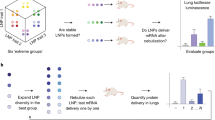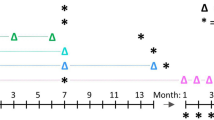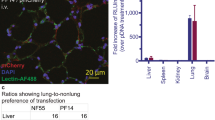Abstract
There is currently an urgent need to develop efficient gene-delivery systems for the lung that are free of inflammatory effects. The LID vector is a synthetic gene delivery system, comprised of lipofectin (L), an integrin-targeting peptide (I) and DNA (D) that has previously been shown to have high transfection efficiency in the lung. We have assessed the effect of alternative methods of complex preparation on structural features of the complex, levels and duration of reporter gene expression and the host response to the LID vector. We have demonstrated that making the complex in water affects the structure of the LID complexes making them smaller and more stable with a more cationic surface charge than complexes prepared in phosphate-buffered saline (PBS). When the LID vector was constituted in water and instilled intratracheally into the lungs of mice there was a 10-fold increase in luciferase activity compared with preparation in PBS. Furthermore, luciferase activity was still evident 1 week following vector instillation. This enhancement may be because of altered complex structure, although effects of the hypotonic vector solution on the lung cannot be excluded. The inflammatory effects of instilling the LID vector in water were minimal, even after three administrations of the LID vector, with only mild alterations in cytokine and broncho-alveolar lavage fluid (BALF) cell profiles. These results demonstrate that the LID vector can generate high, and prolonged, levels of gene expression in the lung from small quantities of DNA and that careful attention to synthetic polyplex structure may be important to optimize efficiency of gene expression in vivo.
This is a preview of subscription content, access via your institution
Access options
Subscribe to this journal
Receive 12 print issues and online access
$259.00 per year
only $21.58 per issue
Buy this article
- Purchase on Springer Link
- Instant access to full article PDF
Prices may be subject to local taxes which are calculated during checkout







Similar content being viewed by others
References
Kay MA et al. Evidence for gene transfer and expression of factor IX in haemophilia B patients treated with an AAV vector. Nat Genet 2000; 24: 257–261.
Yla-Herttuala S, Martin JF . Cardiovascular gene therapy. Lancet 2000; 355: 213–222.
Khuri FR et al. A controlled trial of intratumoral ONYX-015, a selectively replicating adenovirus, in combination with cisplatin and 5-fluorouracil in patients with recurrent head and neck cancer. Nat Med 2000; 6: 879–885.
Cavazzana-Calvo M et al. Gene therapy of human severe combined immunodeficiency (SCID)-X1 disease. Science 2000; 288: 669–672.
Alton EW et al. Cationic lipid-mediated CFTR gene transfer to the lungs and nose of patients with cystic fibrosis: a double-blind placebo-controlled trial. Lancet 1999; 353: 947–954.
Bellon G et al. Aerosol administration of a recombinant adenovirus expressing CFTR to cystic fibrosis patients: a phase I clinical trial. Hum Gene Ther 1997; 8:15–25.
Crystal RG et al. Administration of an adenovirus containing the human CFTR cDNA to the respiratory tract of individuals with cystic fibrosis. Nat Genet 1994; 8: 42–51.
Hart SL et al. Lipid-mediated enhancement of transfection by a nonviral integrin-targeting vector. Hum Gene Ther 1998; 9: 575–585.
Jenkins RG et al. An integrin-targeted non-viral vector for pulmonary gene therapy. Gene Ther 2000; 7: 393–400.
Sawa T et al. Intraluminal water increases expression of plasmid DNA in rat lung. Hum Gene Ther 1996; 7: 933–941.
Wang G et al. Influence of cell polarity on retrovirus-mediated gene transfer to differentiated human airway epithelia. J Virol 1998; 72: 9818–9826.
Wang G et al. Increasing epithelial junction permeability enhances gene transfer to airway epithelia in vivo. Am J Respir Cell Mol Biol 2000; 22: 129–138.
Ogris M et al. The size of DNA/transferrin–PEI complexes is an important factor for gene expression in cultured cells. Gene Ther 1998; 5: 1425–1433.
Li S Rizzo MA, Bhattacharya S, Huang L . Characterization of cationic lipid–protamine–DNA (LPD) complexes for intravenous gene delivery. Gene Ther 1998; 5: 930–937.
Ferkol T et al. Gene transfer into the airway epithelium of animals by targeting the polymeric immunoglobulin receptor. J Clin Invest 1995; 95: 493–502.
Scheule RK et al. Basis of pulmonary toxicity associated with cationic lipid-mediated gene transfer to the mammalian lung. Hum Gene Ther 1997; 8: 689–707.
Floch V et al. Systemic administration of cationic phosphonolipids/DNA complexes and the relationship between formulation and lung transfection efficiency. Biochim Biophys Acta 2000; 1464: 95–103.
Yei S et al. Adenovirus-mediated gene transfer for cystic fibrosis: quantitative evaluation of repeated in vivo vector administration to the lung. Gene Ther 1994; 1: 192–200.
Yang Y, Li Q, Ertl HC, Wilson JM . Cellular and humoral immune responses to viral antigens create barriers to lung-directed gene therapy with recombinant adenoviruses. J Virol 1995; 69: 2004–2015.
Zabner J et al. Repeat administration of an adenovirus vector encoding cystic fibrosis transmembrane conductance regulator to the nasal epithelium of patients with cystic fibrosis. J Clin Invest 1996; 97: 1504–1511.
Meng Q-H et al. Transfection of confluent epithelial cells with an integrin-targeted synthetic vector. Mol Ther 2000; 1: s245–s246.
Zabner J et al. Comparison of DNA–lipid complexes and DNA alone for gene transfer to cystic fibrosis airway epithelia in vivo. J Clin Invest 1997; 100: 1529–1537.
Meyer KB et al. Intratracheal gene delivery to the mouse airway: characterization of plasmid DNA expression and pharmacokinetics. Gene Ther 1995; 2: 450–460.
Tsan MF, White JE, Shepard B . Lung-specific direct in vivo gene transfer with recombinant plasmid DNA. Am J Physiol 1995; 268: L1052–L1056.
Kukowska-Latallo JF et al. Intravascular and endobronchial DNA delivery to murine lung tissue using a novel, nonviral vector. Hum Gene Ther 2000; 11: 1385–1395.
Agostini C, Siviero M, Semenzato G . Immune effector cells in idiopathic pulmonary fibrosis. Curr Opin Pulmon Med 1997; 3: 348–355.
Scheule RK, Cheng SH . Airway delivery of cationic lipid:DNA complexes for cystic fibrosis. Adv Drug Deliv Rev 1998; 30: 173–184.
Freimark BD et al. Cationic lipids enhance cytokine and cell influx levels in the lung following administration of plasmid:cationic lipid complexes. J Immunol 1998; 160: 4580–4586.
McLachlan G, Stevenson BJ, Davidson DJ, Porteous DJ . Bacterial DNA is implicated in the inflammatory response to delivery of DNA/DOTAP to mouse lungs. Gene Ther 2000; 7: 384–392.
Goddard CA et al. A second dose of a CFTR cDNA–liposome complex is as effective as the first dose in restoring cAMP-dependent chloride secretion to null CF mice trachea. Gene Ther 1997; 4: 1231–1236.
Hyde SC et al. Repeat administration of DNA/liposomes to the nasal epithelium of patients with cystic fibrosis. Gene Ther 2000; 7: 1156–1165.
Gill D, Pringle I, Davies L, Hyde S . The effect of dosing interval on reporter gene expression in mouse lung. Mol Ther 2001; 3: S68 (Abstract).
Van de Hulst HC . Light Scattering by Small Particles. John Wiley & Sons: New York, NY. 1957.
Bradford MM . A rapid and sensitive method for the quantitation of microgram quantities of protein utilizing the principle of protein–dye binding. Anal Biochem 1976; 72: 248–254.
Ashcroft T, Simpson JM, Timbrell V . Simple method of estimating severity of pulmonary fibrosis on a numerical scale. J Clin Pathol 1988; 41: 467–470.
Acknowledgements
The liposome DOTMA/DOPE in a 1:1 molar ratio was generously provided by Valentis Inc. (Burlingame, CA, USA). RGJ is an ARC Clinical Research Fellow. The study was supported by the Arthritis Research Campaign, the Wellcome Trust, and the British Lung Foundation.
Author information
Authors and Affiliations
Rights and permissions
About this article
Cite this article
Jenkins, R., Meng, QH., Hodges, R. et al. Formation of LID vector complexes in water alters physicochemical properties and enhances pulmonary gene expression in vivo. Gene Ther 10, 1026–1034 (2003). https://doi.org/10.1038/sj.gt.3301963
Received:
Accepted:
Published:
Issue Date:
DOI: https://doi.org/10.1038/sj.gt.3301963
Keywords
This article is cited by
-
Minicircle DNA Provides Enhanced and Prolonged Transgene Expression Following Airway Gene Transfer
Scientific Reports (2016)
-
Role of liposome and peptide in the synergistic enhancement of transfection with a lipopolyplex vector
Scientific Reports (2015)
-
Multifunctional nanocomplexes for gene transfer and gene therapy
Cell Biology and Toxicology (2010)
-
A Receptor-targeted Nanocomplex Vector System Optimized for Respiratory Gene Transfer
Molecular Therapy (2008)



